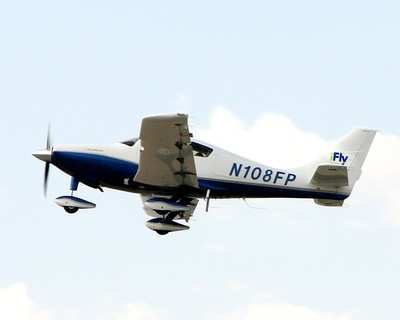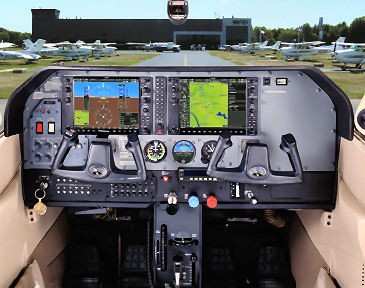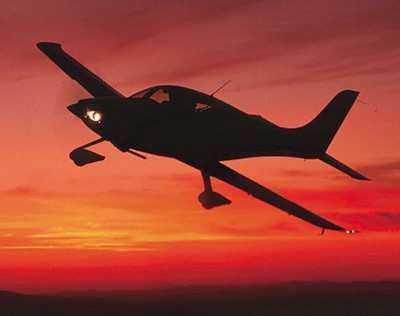Is It The Right Option For You?
By ANN Contributor Thomas P. Turner
 Fractional
ownership.
Fractional
ownership.
This aircraft ownership option has seemingly sprouted almost
from nowhere in the last few years. Although fractional ownership
of professionally flown turbine aircraft appeared a few years
earlier, the rise of owner-flown fractional ownerships began
concurrently with the introduction of what we now call Technically
Advanced Aircraft (TAA)--airplanes with moving-map GPS and
autopilot technology, more and more frequently with "glass cockpit"
Primary Flight Display (PFD)/Multifunction Display (MFD)
panels.
Does fractional ownership make sense to pilots who fly
piston-powered airplanes? What are the deciding points on buying
into a fractional? What are the unique benefits of fractionals that
offset some of the costs? When are you ahead of the game to bypass
fractionals and buy an airplane outright? What might you consider
to decide whether fractional ownership makes sense for you?
To answer these questions ANN has spent several months
researching fractional ownership of owner-flown, piston-powered
airplanes. We've surveyed readers like you who are fractional
owners, who are currently considering buying into a fractional
program, or have been fractional owners but have left the program
for one reason or another. We've also polled managers of
fractionals. With this cross-section, we got a sense of each
perspective toward fractional ownership of owner-flown piston
airplanes-you'll see quotes from several ANN readers' responses as
you read this report.
What's a fractional?
Fractional ownership is a unique type of aircraft ownership,
distinctive from other forms primarily because of the services
included by the program management. Some pilots may be unclear
exactly what is meant by "fractional ownership", so let's spell out
the differences between fractionals and other ownership
schemes:
- Sole ownership. Sole or outright ownership is
when a single person, usually the pilot, has the only ownership
stake in the aircraft. Sometimes the airplane is registered solely
in that person's name, sometimes a spouse or other relative (who
may or may not be a pilot) is included in the title, and sometimes
the sole owner registers the airplane in a corporation name,
whether that corporation has any business other than that of owning
and operating the aircraft. A short description of sole ownership
is that one person (or corporation) pays all the bills. The sole
owner is wholly responsible for aircraft scheduling and
maintenance, aircraft storage, insurance, and all other aspects of
ownership.
- Co-ownership. If more than one person handles
ownership responsibilities and operational expenses the airplane is
considered to be in a co-ownership. It may be registered in the
names of all who have an ownership stake (two or more), or in a
corporation or other legal partnership agreement. It's advantageous
for the co-owners to have a signed agreement that spells out each
person's responsibilities. Significantly, aviation insurance
premiums are usually "rated", or determined, by the experience
level of the least experienced pilot. So a co-ownership agreement
may dictate a formula for determining the percentage of insurance
premium each member is responsible for that takes each pilots'
affect on premiums into account-a less-experienced pilot may pay
more of the fixed costs of the co-ownership if it would cost the
other owners less without him or her.
- Flying clubs. Flying clubs are another form of
co-ownership, with some differences. Flying clubs are almost always
legally chartered organizations, usually a not-for-profit
corporation or LLC operated at break-even prices. Clubs usually
have a few to dozens of member-pilots, and often own multiple
airplanes. The club may employ its own instructors and/or
mechanics. Flying clubs usually have officers or a board of
directors to set policies and ensure all ownership, financial and
legal requirements are met. Individuals buy membership in the
organization and may sell that membership to others; they'll pay an
entry fee, a monthly fee, and a per-hour operating fee that is
usually attractive compared to renting similar aircraft on the open
market.

By contrast a fractional ownership program is one where a
for-profit business organization owns an airplane or airplanes, and
sells access to those aircraft to a limited number of fractional
owners. What the "owner" actually owns varies with (and sometimes,
within) a fractional program's organization-members may own:
- The "right to use" of one or more of the program's aircraft;
or
- An actual financial interest ("equity") in a specific aircraft
within the fractional program. This is where "fractionals" get
their name-equity owners legally own a specified "fraction" of the
aircraft (e.g., "1/16th interest", "1/8th interest", "1/4th
interest", etc.)
Fractional ownership is closer to the flying club model than any
other type of ownership, but there are significant differences even
between flying clubs and fractionals.
"Fractional ownership actually costs more than ownership,
but yet you can be flying a state-of-the-art new airplane for a
little bit more money than owning older planes outright." --
Current fractional owner.
A "right to use" ownership generally has strict limits on the
number of hours the owner may use the program's airplane(s)
annually. These fractional owners are essentially admitted into a
small group that has exclusive rights to rent one or more airplanes
in the program.

Equity ownership is usually less restrictive. Members can fly
the airplane more. In most cases an equity owner buys into an
airplane that will be owned for a period of time (typically four
years) and then traded for a new airplane. The idea is that owners
can continue to enjoy the benefits of flying very late-model
equipment within the fractional framework.
One fractional manager responded to ANN's survey of fractional
owners with a description of his program's options:
"We offer four unique levels of reservations access (Bronze,
Silver, Gold, & Platinum). This flexibility allows each owner
to purchase the ownership that is right for them and depends on how
many hours per year the pilot wants to fly and their desired
advance reservation privileges. Within their privileges, it is a
first-come, first-served system (i.e. no owner can bump another one
out of their existing reservation). Owners can take the aircraft
away for up to 10 days at a time and each owner is permitted one
reservation per year outside of their reservation
privileges."
It may be telling that, almost without exception, readers who
responded to the ANN survey stating they are pleased with
fractional ownership live within a five- to 20-minute drive from a
fractional location that has multiple identical airplanes...
airplanes are available and close by.
Service: what sets fractionals apart
The biggest difference with fractionals, however, is the
professional management of the aircraft. For many fractional owners
this is the biggest advantage of fractional ownership. Fractional
companies employ managers that oversee all aspects of aircraft
ownership, so all the pilot has to do is (as one survey respondent
wrote) "show up and fly". Most fractionals provide valet-like
service to their members-the airplane is sitting in front of the
fractional's private FBO when the pilot arrives, cleaned and fueled
per the pilot's orders; at the end of the flight the pilot stops in
front of the FBO, unloads and leaves, with the fractional company
fueling and cleaning the plane and putting it in the hangar. Some
fractionals even provide sanitized headsets and chart services,
with en route and approach charts for the specific trip arranged in
the cockpit based on the pilot's directions. If the fractional
owner lives some distance from the program's home base, some
fractionals will pick up and deliver to an airport closer to the
owner.
In all, it's more like being a premium member of a luxury car
rental agency than a traditional piloting experience.

Other common amenities: private FBO lounges with kitchen and
restroom facilities, computer-equipped flight planning rooms,
on-line scheduling and flight planning, and designated parking
spaces in the FBO parking lot.
Coming Wednesday: Fractionals Offer A 'New
Perspective' In Several Areas
 ANN's Daily Aero-Linx (04.16.24)
ANN's Daily Aero-Linx (04.16.24) Aero-News: Quote of the Day (04.16.24)
Aero-News: Quote of the Day (04.16.24) Airborne 04.10.24: SnF24!, A50 Heritage Reveal, HeliCycle!, Montaer MC-01
Airborne 04.10.24: SnF24!, A50 Heritage Reveal, HeliCycle!, Montaer MC-01 Airborne 04.12.24: SnF24!, G100UL Is Here, Holy Micro, Plane Tags
Airborne 04.12.24: SnF24!, G100UL Is Here, Holy Micro, Plane Tags Airborne-Flight Training 04.17.24: Feds Need Controllers, Spirit Delay, Redbird
Airborne-Flight Training 04.17.24: Feds Need Controllers, Spirit Delay, Redbird






